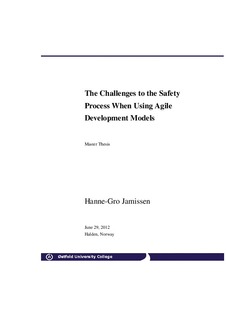The challenges to the safety process when using Agile development models
Master thesis
Permanent lenke
http://hdl.handle.net/11250/148044Utgivelsesdato
2012-10-04Metadata
Vis full innførselSamlinger
Sammendrag
Safety related systems are traditionally developed using traditional models like the V-model. Agile development models are now increasingly used, and the experiences with these models makes
it tempting to also use Agile models when developing safety related systems. To do this, Agile development models need include a safety process that also are as agile as possible. However, introducing safety activities into an agile environment reintroduces limitations from traditional de-velopment. The challenge is to reduce these limitations, so that the benefits of Agile development can be utilized also when developing safety related systems, and still maintain the expected level of
safety. The current thesis identifies and investigates some of the challenges to the safety process from IEC 61508 when using an Agile development process. The thesis starts by giving an overview
of traditional development, Agile development and the safety process, before examining literature concerning Agile models used for developing safety related systems. To simplify the discussion, the safety process is grouped into three areas: safety analysis, safety assessment, and safety validation.
Agile development is also divided into three groups: the incremental part, the iterative part, and main Agile practices not covered by the two first discussions.
The discussion starts with examining all the incremental implications to each of the safety pro-cess groups. Then the iterative implications are discussed, and finally the implications of the re-maining practices are considered. The discussion is summarized by giving a suggestion for a more agile safety process, based on the Scrum model.
